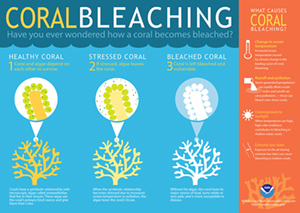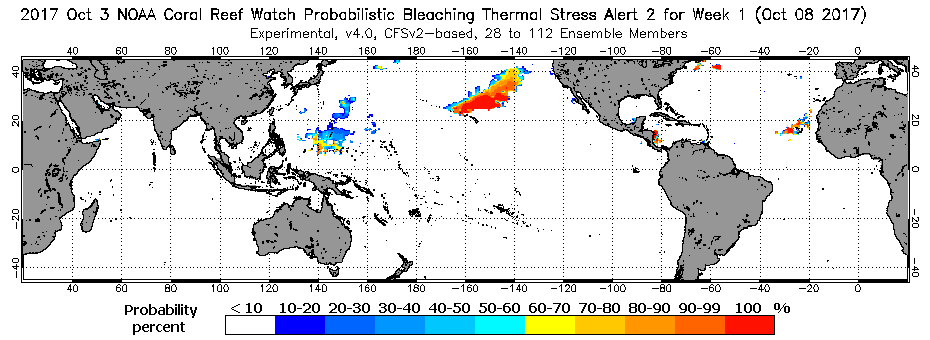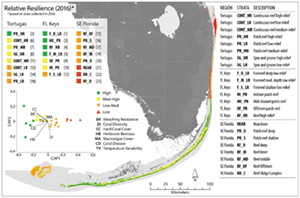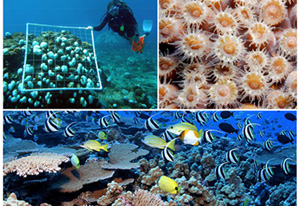-
Home
-
Data & Publications
-
Regional Portals
- About Regional Portals
- Florida
- Navassa Island
- Puerto Rico
- Flower Garden Banks
- U.S. Virgin Islands
- American Samoa
- Commonwealth of the Northern Mariana Islands
- Federated States of Micronesia
- Guam
- Main Hawaiian Islands
- Republic of the Marshall Islands
- Northwestern Hawaiian Islands
- Republic of Palau
- Pacific Remote Island Areas
-
CRCP Activities
- Glossary
The Coral Program's Climate Change & Reef Resilience Activities

Climate change is the greatest global threat to coral reef ecosystems. As temperatures rise, mass coral bleaching events and infectious disease outbreaks are becoming more frequent. Additionally, carbon dioxide absorbed into the ocean from the atmosphere has already begun to reduce calcification rates in reef-building and reef-associated organisms by altering seawater chemistry through decreases in pH. This process is called ocean acidification. Climate change will also affect coral reef ecosystems, through sea level rise, changes to the frequency and intensity of tropical storms, and altered ocean circulation patterns. When combined, all of these impacts dramatically alter ecosystem function, as well as the goods and services coral reef ecosystems provide to people around the globe. You can view and download an infographic on how climate change dramatically affects coral reef ecosystems at this NOAA Oceans Service website.
The NOAA Coral Reef Conservation Program is actively working with its partners to address the impacts of climate change and ocean acidification on coral reef ecosystems. The Program promotes resilience-based management as the best strategy to achieve management goals in a changing climate. Resilience-based management involves using knowledge of current and future drivers of ecosystem condition and function to identify, prioritize, and adapt management actions that sustain ecosystem resilience and human wellbeing.
The CRCP supports research, management and capacity building projects and programs that increase the capacity of the coral reef jurisdictions to address the threat of climate change. This webpage collates and profiles these projects, providing access to tools and toolkits, maps, articles, reports, guides and educational outreach materials the Program has invested in over recent years and continues to support with our many partners.
Projects have been grouped into three areas of focus: understanding past, present and projected future impacts to coral reefs caused by coral bleaching, assessing and understanding likely social and ecological responses to climate change, and, identifying and prioritizing management actions to support ecosystem resilience and human wellbeing.
Understanding past, present and projected future impacts to coral reefs
History of Thermal Stress on Reefs
As many of the world's reefs are remote, there is limited information on how past thermal conditions have influenced reef composition and current stress responses. Using satellite temperature data for 1985-2012, a NOAA team developed the first analysis for global reef locations that quantified spatial variation in warming trends, thermal stress events and temperature variability at reef-scale (~4 km). Among 60,000 reef pixels globally, 97% show positive SST trends during the study period with 60% warming significantly. Annual trends exceeded summertime trends at most locations. This indicates the period of summer-like temperatures has become longer through the record, with a corresponding shortening of the 'winter' reprieve from warm temperatures. The frequency of bleaching-level thermal stress increased three-fold between 1985-91 and 2006-12 - a trend climate model projections (see section of this webpage below) suggest will continue. The thermal history data products developed enable needed studies relating thermal history to bleaching resistance and community composition. Such studies can help identify reefs more resilient to thermal stress.
Coral Reef Watch (Near-real-time Monitoring and Seasonal Outlooks)
The NOAA Coral Reef Watch (CRW) mission is to utilize remote sensing and in situ tools for near-real-time and long term monitoring, modeling and reporting of physical environmental conditions of coral reef ecosystems. NOAA CRW uses satellite data to provide current reef environmental conditions to quickly identify areas at risk for coral bleaching.

NOAA CRW also offers a modeled Coral Bleaching Heat Stress Outlook that predicts the likelihood of coral bleaching heat stress on a week-by-week basis, up to four months in the future (the typical length of a bleaching season).
Continuous satellite monitoring of sea surface temperature at global scales and modeled predictions of approaching bleaching-level heat stress provide resource managers, researchers, and other stakeholders with tools to understand and better manage the complex interactions leading to coral bleaching. When bleaching conditions occur, these tools can be used to trigger bleaching response plans and support appropriate management decisions and communication with the public. Additional remote sensing based tools and products can be found on their website at www.coralreefwatch.noaa.gov.
Climate Modeling
Coral reefs and the services they provide are seriously threatened by ocean acidification and climate change impacts, like coral bleaching. Bleaching events are expected to become more frequent and more severe in the decades ahead. Teams working with the CRCP developed model projections of the timing of when severe bleaching conditions (i.e. thermal stress >8 DHWs) occurs twice per decade and on an annual basis. Coral communities will start to change when bleaching events occur more than twice in a decade-corals that are susceptible to bleaching will be less common on reefs and the structural complexity of many coral reefs will decline. These changes will occur more rapidly if/when bleaching events begin to occur annually.
The projections for the two bleaching scenarios have been produced for emissions scenarios RCP8.5 and RCP4.5. RCP8.5 is a 'no climate policy' scenario that assumes emissions increase unabated. At time of writing in May of 2016, emissions concentrations were greater than what RCP8.5 projected for 2016. RCP4.5 assumes emissions stabilize just after 2100 due to successful implementation of climate policies that reduce emissions. Projections have been developed for both bleaching and for ocean acidification at the resolution of climate model data (~1x1°) and these are available here. Statistically downscaled projections (4-km) are also available for bleaching here.
The projections results are available here in the form of Google Earth files, map images, and ArcGIS-compatible spatial data. The projections can also be viewed here on the UNEPLive site under the Coral Reefs theme. The articles and reports available below describe the main findings from these projects and discuss the conservation, management and policy applications of the projections.
- Climate Impact Summaries
- Coral Bleaching Futures - Downscaled projections of bleaching conditions for the world’s coral reefs, implications of climate policy and management response (2017; 4km resolution)
- Local-scale projections of coral reef futures and implications of the Paris Agreement (2016)
- Downscaled climate model projections of coral bleaching conditions (Data/Images; 4km resolution)
- Projections of Coral Bleaching and Ocean Acidification for Coral Reef Areas (Data/Images; 1°x 1° resolution)
- Downscaled projections of Caribbean coral bleaching that can inform conservation planning (2015)
- Opposite latitudinal gradients in projected ocean acidification and bleaching impacts on coral reefs (2014)
- Temporary refugia for coral reefs in a warming world (2013)
Assessing and Understanding social and ecological response to climate change
Reef Resilience Assessments

Maintaining and restoring resilience is now a major focus of most coral reef managers around the world. The application of resilience theory to management planning and the day-to-day business of coral reef management has been challenging. One of the key stumbling blocks has been the lack of a robust and easily implementable method for assessing coral reef resilience in a way that can inform marine spatial planning and help to prioritize the implementation of management strategies.
Our ability to assess relative resilience of coral reefs has advanced dramatically in recent years, and we are now at a point where a feasible and useful process can be recommended for use in environmental planning and management. The Guide accessible at the link below presents a 10-step process for completing a resilience assessment, putting into managers' hands the means to assess, map and monitor coral reef resilience, and the means to identify and prioritize actions that support resilience in the face of climate change. The guidance presented here represents the culmination of over a decade of experience and knowledge sharing among many NOAA partners.
The other reports available at links below are case examples of resilience assessments that have been completed and are informing the targeting and tailoring of management actions.
- Spatial Prioritization under Resilience Based Management: Evaluating Trade-offs among Prioritization Strategies
- A framework for identifying and characterising coral reef "oases" against a backdrop of degradation
- A Guide to assessing coral reef resilience for decision support (2017)
- Assessing relative resilience potential of coral reefs to inform management (2015)
- Prioritizing Key Resilience Indicators to Support Coral Reef Management in a Changing Climate (2012)
American Samoa
- Coral Reef Resilience and Social Vulnerability to Climate Change: American Samoa
- Identifying coral reef resilience potential in Tutuila, American Samoa based on NOAA coral reef monitoring data (2018)
Commonwealth of the Northern Mariana Islands
- Coral Reef Resilience and Social Vulnerability to Climate Change: CNMI
- Assessing relative resilience potential of coral reefs to inform management in the Commonwealth of the Northern Mariana Islands (2015)
- Coral reef resilience to climate change in Saipan, CNMI; field-based assessments and implications for vulnerability and future management (2012)
- Project Repository - includes data files, webinars and related documents
Florida
Guam
- Coral Reef Resilience and Social Vulnerability to Climate Change: Guam
- Coral Reef Resilience to Climate Change in Guam in 2016
Hawaii
- Coral Reef Resilience and Social Vulnerability to Climate Change: Main Hawaiian Islands
- Assessing the Resilience of Leeward Maui Reefs to Help Design a Resilient Managed Area Network
- Relative resilience potential and bleaching severity in the West Hawaii Habitat Focus Area in 2015
- Reefs for the future: Resilience of coral reefs in the main Hawaiian Islands
- Project Repository: includes data files and additional documentation
U.S. Virgin Islands
Science to Support Resilience Assessments
- Monitoring Herbivorous Fishes as Indicators of Coral Reef Resilience in American Samoa
- Transport Pathways of Marine Larvae Around the Mariana Archipelago
Local Early Action Planning/Vulnerability Assessment
Tropical coastal communities face the impacts of climate change with increasing frequency and severity, which exacerbates existing local threats to natural resources and the societies that depend on them. The LEAP Guide is organized into four major steps to support the integration of planned adaptation within the context of existing development objectives and plans and ongoing projects and programs. Intended users include national and local governments, marine and coastal managers, disaster managers, and community development practitioners who work with coastal communities on a wide range of development issues such as food security, health, biodiversity conservation, and economic development.
- The Local Early Action Planning (LEAP) Tool: Enhancing Community-based Planning for a Changing Climate (2015)
- Climate Change Adaptation for Coral Triangle Communities: A Guide for Vulnerability Assessment and Local Early Action Planning (LEAP Guide) (2013)
- Adapting to Climate Change: Guide to Local Early Action Planning (LEAP) and Management Planning (2013)
- Towards Ecosystem-based Coastal Area and Fisheries Management in the Coral Triangle: Integrated Strategies and Guidance (2013)
LEAP Video Toolkit
- LEAP Tutorial for Climate Change Planning Video
- LEAP Water Video
- LEAP Agriculture Video
- LEAP Shorelines and Nearby Structures Video
- LEAP Marine Resources Video
- LEAP Climate Change Video
- Nimpal Channel Marine Conservation Area Case Study Video
- Hatohobei Island and Helen Reef Program Case Study Video
Identifying and prioritizing management actions to support ecosystem resilience and human-wellbeing
Corals & Climate Adaptation Planning Project

Climate change and its impact on natural resources such as coral reefs has caused numerous complex issues in the field of conservation planning and management. Responses to climate change require actions across multiple spatial and temporal scales. Because of this, there is a need for structured approaches to adaptation planning that combine proven methods of vulnerability assessment with effective adaptation responses. With this in mind, the Corals and Climate Adaptation Planning project of the U.S. Coral Reef Task Force developed guidelines for improving coral reef management through a climate-smart approach.
- Adaptation Design Tool for Climate-Smart Management of Coral Reefs and Other Natural Resources (2018)
- Climate-smart Design for Ecosystem Management: A Test Application for Coral Reefs (2017)
- Adaptation Design Tool: Corals and Climate Adaptation Planning (2017; guide)
- Adaptation Design Tool: Corals and Climate Adaptation Planning (2017; online training module)
TNC Reef Resilience Toolkit and Network
The Reef Resilience Network is a partnership effort led by The Nature Conservancy (TNC) that builds the capacity of reef managers and practitioners around the world to better address the on coral reefs from climate change and other stressors.
The Reef Resilience Network has the following main component:
- Access to new coral reef science and management strategies for coral reef practitioners through the following online modules: Resilience, Coral Reef, Coral Reef Fisheries, Restoration, and Community-based Climate Adaptation.
- Communication to coral reef managers worldwide on new resources and tools for managing for resilience.
- Virtual capacity-building that is implemented through the Reef Resilience online course, a webinar series, and the Reef Resilience Network Forum.
- Intensive in-person trainings and experiences for coral reef managers in order to improve management techniques on the ground through Training of Trainers Workshops and learning exchanges. This includes seed funding for on-the-ground trainings led by workshop participants.
The online content and course provide detailed information and tutorials on conducting resilience assessments and provide case studies of resilience assessments and managing reefs to support resilience from around the world.
Outreach Materials
- What is coral bleaching? - Infographic
- Threats to Coral Reefs: Climate Change - Infographic
- NOAA Ocean Podcast: Reef Resilience (Episode 10)
- Climate, reefs, and resilience - Video
- Top 10 Things You Can Do Before, During, and After a Bleaching Event


